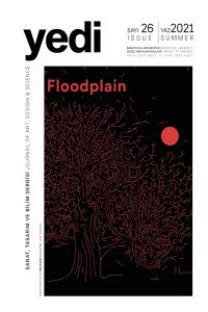Türk Müziği İcralarının Analizi için bir MIDI Projesi
Müzik teknolojisi alanındaki bu çalışmamız Türk müziği icralarının MIDI formatına dönüştürülmesi yöntemini uygulamalıörneklerle birlikte açıklamaktadır. MIDI formatı yaygın olarak batı müzikleri için kullanılan simgesel bir müzik temsil formatıolmasına karşılık içerdiği perde kaydırma (pitch bend) işlevi sayesinde, Türk müziği gibi Batı müziğinin 12 ton eşit yedirimlises sisteminden farklı ses sistemlerini de temsil edebilme kapasitesine sahiptir. Bu anlamda Türk müziği’nin MIDI formatıylatemsil edilmesi çeşitli çalışmalarda gerçekleştirilmiş ve kendi başına herhangi bir yenilik içermemektedir. Diğer yandan butür çalışmalarda MIDI’nin temsil ettiği şey notası yazılı olan eserlerdir. Oysa Türk müziği icralarının notasyon ile ilişkisininproblemli olduğu bilinmektedir. Kısaca kuram ve icra arasındaki farklılıklar nedeniyle notasyon ile temsil edilemeyen perdelervardır. Bu nedenle bu çalışmanın özgünlüğü icradaki perde zenginliğini MIDI formatında nasıl temsil edilebileceğinigöstermesidir. Böylece bu çalışmada Türk müziği üzerine araştırmalarda kullanılabilecek yeni bir araç tanımlanmıştır.
Anahtar Kelimeler:
Geleneksel Türk sanat müziği, Türk müziği, MIDI, perde sistemleri, perde aralıkları
-
Our study within the domain of Music Technology presents the method of writing Turkish music performances in MIDI format by applied samples. Althouh MIDI format is a kind of symbolic representation of music widely used for Western music, the pitch bend function enables MIDI to represent musics which do not have 12 tone equal tempered tuning sysytem such as Turkish music. In this sense representation of Turkish music in MIDI format has been achieved in various studies. On the other hand only the notation of pieces were represented in such studies. It is well known that the relation between the notation and performance has serious problems. Briefly there exists pitches performed in Turkish music which have no correspondence in notation. Therefore, contribution of our study is the presentation of the richness of pitches in performances by writing them in MIDI format. Finally, this new tool can be used for the ethnomusicological and educational studies on Turkish music
Keywords:
Traditional Turkish art music, Turkish music, MIDI, tuning systems, pitch intervals,
___
- Akkoç, C. (2002). “Non-Deterministic Scales Used in Traditional Turkish Music”, Journal of New Music Research, vol. 31, no. 4. pp. 285-293.
- Al-Taee, M. A., Al-Ghawanmeh, M. T., Al-Ghawanmeh, F.M. and Al- Own, B. O. A. (2009). “Analysis and Pattern Recognition of Woodwind Musical Tones Applied to Query-by-Playing”, Proceedings of the World Congress on Engineering 2009 Vol I WCE 2009, July 1 - 3, 2009, London, U.K.
- Boehm, C. (2007). “The Discipline that Never was: Current Developments in Music Technology in Higher Education in Britain”, Journal of Music, Technology and Education, 1 (1): 7-21.
- Bozkurt, B. (2008). “An Automatic Pitch Analysis Method for Turkish Maqam Music”. Journal of New Music Research, 37(1): 1-13.
- Bozkurt, B., Yarman, O., Karaosmanoğlu, M. K. and Akkoç, C. (2009). “Weighing Diverse Theoretical Models on Turkish Maqam Music Against Pitch Measurements: A Comparison of Peaks Automatically Derived from Frequency Histograms with Proposed Scale Tones”, Journal of New Music Research, 38 (1): 45-70.
- Durmaz, Serhad, (2000). MIDI. İzmir: Dokuz Eylül Yayınları.
- Gedik, A. C., Bozkurt, B. And Cirak, C. (2009). “A Study of Fret Positions of Tanbur Based on Automatic Estimates from Audio Recordings”, Proc. CIM09 (Conference on Interdisciplinary Musicology), 26- 29 Oct., Paris. http://cim09.lam.jussieu.fr/CIM09-fr/Actes_files/18A- GedikBozkurtCirak.pdf (05.11.2012)
- Gedik, A. C. and Bozkurt, B. (2009). “Evaluation of the Makam Scale Theory of Arel for Music Information Retrieval on Traditional Turkish Art Music”, Journal of New Music Research, 38 (2): 103-116.
- _____ (2010). “Pitch Frequency Histogram Based Music Information Retrieval for Turkish Music”, Signal Processing, 10:1049-1063.
- Gedik, A. C. , Işıkhan, C., Alpkoçak, A., Özer, Y. (2005). “Automatic Classification of 10 Turkish Makams”, Istanbul Technical University, International Congress on Representation in Music & Musical Representation, Istanbul.
- Gedik, A. C. (2012). Automatic transcription of tradıtıonal Turkish art music recordings: A computational ethnomusicology approach, PhD Thesis, İzmir: İzmir Institute of Technology, Graduate School of Engineering and Sciences.
- Kaçar, G. Y., (2005). “Geleneksel Türk Sanat Müziği’nde Süslemeler ve Nota Dışı İcralar”, GÜ, Gazi Eğitim Fakültesi Dergisi, 25(2): 215- 228.
- Karaosmanoğlu, M. K., (2012). “A Turkish Makam Music Symbolic Database for Music Information Retrieval: Symbtr”, Proceedings of ISMIR, 2012.
- Krishnaswamy, A. (2003). “On the Twelve Basic Intervals in South Indian Classical Music”, AES 115th Convention, New York, USA, 10-13 October 2003, paper no: 5903.
- Marcus, S. (1993). “The Interface between Theory and Practice: Intonation in Arab Music”, Asian Music, 24(2): 39-56.
- Signell, K. (2008). Karl Signell ile ITU’de düzenlenen Türk müziğinde kuram-icra sorunları ve çözümleri isimli uluslararası çağrılı sempozyumda yapılan görüşme, İstanbul: 8 Mart.
- Touma, H. H. (1996). The Music of the Arabs, trans. Laurie Schwartz. Portland, Oregon: Amadeus Press.
- Théberge, Paul (1997). Any Sound You Can Imagine: Making Music/ Consuming Technology, Hanover, N.H.: Wesleyan University Press and the University Press of New England.
- Töre, Abdülkadir ve Ekrem Karadeniz (1965). Türk musikisi nazariye ve esasları, İstanbul: Türkiye İş Bankası Yayınları.
- Tura, Yalçın (1988). Türk Musikisinin Meseleleri. İstanbul: Pan Yayıncılık. Tzanetakis, G., Kapur, A., Schloss, W.A. and Wright, M. (2007). “Computational Ethnomusicology”. Journal of Interdisciplinary Music Studies, 1(2): 1-24.
- Yarman, O. (2008). 79-Tone Tuning & Theory for Turkish Maqam Music. PhD Thesis, İstanbul Technical University, Social Sciences Inst., İstanbul.
- _____ (2010). Nazariyat ve Teknik Boyutlarıyla Ses Dünyamızda Yeni Ufuklar. İstanbul: Artes Yayınları. pp. 64–99.
- Yavuzoğlu, N. (2008). 21. Yüzyılda Türk Müziği Teorisi, İstanbul: Pan Yayıncılık.
- ISSN: 1307-9840
- Başlangıç: 2007
- Yayıncı: Dokuz Eylül Üniversitesi
Sayıdaki Diğer Makaleler
Türk Müziği İcralarının Analizi için bir MIDI Projesi
Oryantalist Resimlerde Türk Halıları
Elvan ÖZKAVRUK ADANIR, Berna İLERİ
Metropolis Filmi: Aydınlanmanın Diyalektiği, Modernite, Mit ve Modern Mimari
Bonhams Müzayedelerinde Satışa Sunulmuş Bir Grup Figürlü İznik Tabağı
Sanatta Avangardın Tüketimi Üzerine
Batıda Çağdaş Feminist Tiyatronun Gelişimi
Antik Yunan’da Toplumsal Cinsiyet Rollerinin Temsili
Osmanlı Saray Şenliklerinden Günümüze Bir Kültür Ürünü: Nahıl
